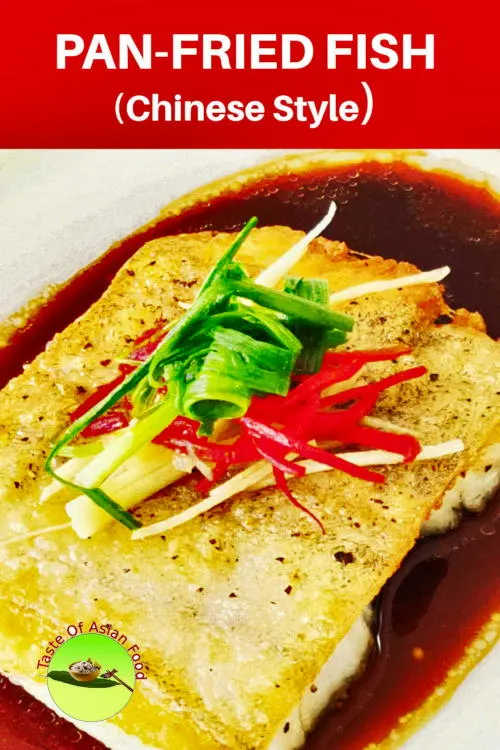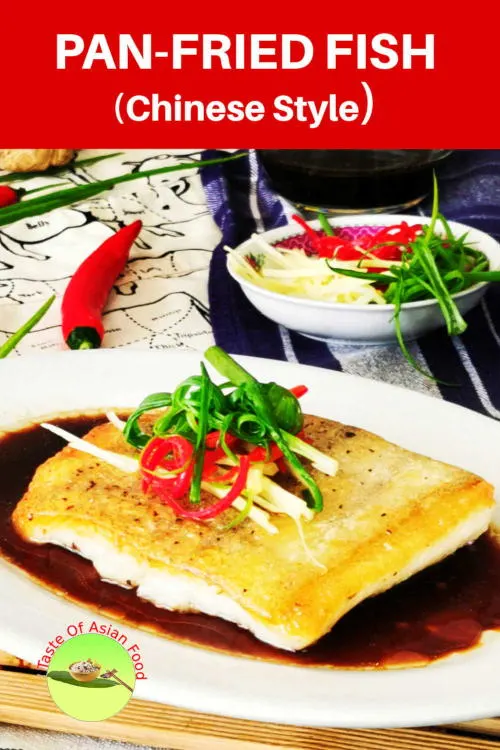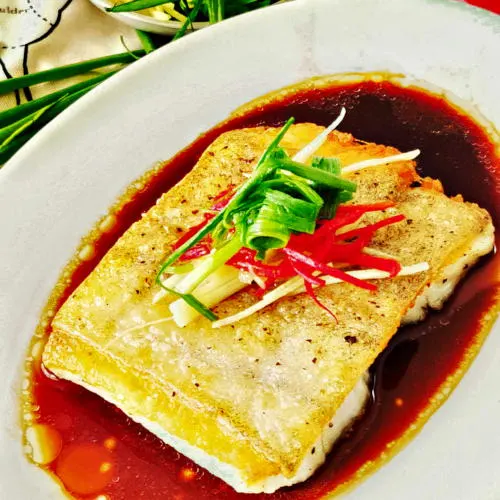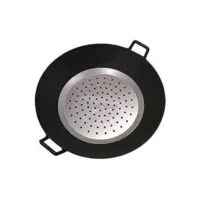This pan-seared halibut recipe is my interpretation of the classic steamed fish Chinese recipe with a twist. It is pan-fried to perfection but dressed with the traditional steamed fish sauce popular among the Cantonese.
The sauce comprises light soy sauce, ginger, garlic, and others. I have tested it, and it works surprisingly well with pan-fried fish.
On the whole, it is a hybridized dish of Asian and Western cuisines. The halibut is pan-fried entirely in Western-style, and the sauce is an authentic recipe for Cantonese steamed fish.
So the best description should be in Chinese 脆皮鱼配蒸鱼酱, which means crispy skin paired with steamed fish sauce
Eager to try? Let’s get into the detail right in.

Note: This post may contain affiliate links. Please read my privacy policy for more info. I may receive commissions for purchases made through links in this post. As an Amazon Associate, I earn from qualifying purchases.
How to pan-fried fish with an Asian twist
1. How to pan-fry fish to perfection
Prepare the fillet for pan-frying
- Clean the fish fillet, then pat dry with a kitchen paper towel.
- Season the fillet with salt and pepper on both sides. It will not be too salty when serving with the sauce since it does not contain salt, only light soy sauce.
- Get some cornstarch and put it in a sieve of a fine wire mesh strainer. Sprinkle the cornstarch on both sides and pat it gently to let it adhere to the surface. Dust off any excess and set aside.
Note
- You can use any fish fillet either with or without the skin. I use halibut, but codfish and salmon are also yielded an excellent result.
- As an alternative, try to substitute the fillet with whole fish, for example, tilapia or pomfret, since most Chinese households use whole fish over the fillet.
- Pat dry the fish with paper towels is essential before pan-frying. First, it helps to reduce the splattering of oil in the pan. Secondly, it must be dry to make the skin crispy.
- You may want to use all-purpose flour to coat the fish instead of cornstarch. However, cornstarch produces a crispier coating. Alternatively, you can pan-fry the fillet without the cornstarch or flour, but the color is less appealing, and the surface can get overcooked quickly.
How to pan-seared halibut (and other fillets)
- Let the halibut fillet return to room temperature if you keep it in the refrigerator.
- Pour a tablespoon of vegetable oil into a nonstick pan, preferably with a heavy bottom. When the oil is heated until you can feel the heat by putting your palm an inch above the pan, place the fish fillet skin side down in the pan.
- Turn the heat to medium-low and leave the fillet undisturbed for the first three minutes. The skin will be less sticky after it crisps up after a few minutes. After that, check the color of the skin occasionally. The total time required to reach light golden is about five to six minutes.
- Flip the fillet to pan-fry the other side. Transfer the fillet to the serving plate when the fish is fully cooked, which takes another two minutes.
Note
- You should pan-fry the fish when it returns to room temperature. The inner part mAY still raw when the surface has turned color if you pan-fry the fillet directly from the refrigerator.
- You can also use a cast iron pan instead of a non-stick pan to pan-fry the fillet. The cast-iron pan must be well seasoned to avoid the fish from sticking. Additional oil is required if you a cast iron pan.
- Medium to low heat is preferred over high heat to pan-fry the fish. The reason is that the oil in the fish will slowly render to form crispy skin. It also allows the heat to have sufficient time to penetrate the inner part of the fillet. The skin may have changed color, but the internal is still raw if you use high heat.
- I cook the skin side much longer than the flesh side to crisp up the skin. Once you flip the fillet, keep an eye on the color of the fillet. Remove it once it is fully cooked when the flesh is no longer looks translucent.
2. How to prepare the sauce for the fish
This recipe is a hybrid of a western-style pan-fried fish with Cantonese sauce. This sauce is commonly called steamed fish sauce 蒸鱼酱 among the Cantonese, as it is almost exclusively used to serve with steamed fish.
Since I noticed the potential to pair the sauce with the pan-seared halibut, I have done some testing on it, and it turns out marvelous.
The crispy skin is one thing that you won’t find in the typical Hong Kong style steamed fish 清蒸鱼.
- You need to saute some aromatics first. Heat some oil in the wok (or pan) over medium heat. Saute the coarsely chopped garlic, coarsely chopped shallots, ginger slices, and scallion in the oil until fragrant.
- Add the premium grade light soy sauce and some water. Let it simmer over low heat for ten minutes to extract the flavor.
- Add some Shaoxing wine, sesame oil, and ground white pepper. Mix well.
- Pour the sauce through a wire mesh strainer to catch all the aromatics.
Note
- Keep the amount of oil for sauteing the aromatics to a minimum, as we will splash some boiling oil onto the topping of the fish later.
- You do not need to cut the aromatic finely as the purpose is to infuse the flavor into the liquid. The flavor should release fully after simmer for ten minutes.
- The final flavor depends mainly on the quality of the soy sauce. Therefore, please choose a premium grade light soy sauce for this recipe.
- Some people mistakenly thought that this sauce is just soy sauce. In reality, it is prepared with multiple ingredients!

3. Topping for the fish
The topping for the fish is a mix of sliced ginger, scallion, and red chili. These items serve two purposes. First, it looks gorgeous with a combination of green, yellow, and red. Secondly, they release additional flavor when the hot oil splashes on them at the last stage of preparation.
- Cut the scallion into 2-3 inches length, then slice them lengthwise as thin as possible. Place the sliced scallion in some cold water for a few minutes. Remove and let it drains on a paper towel. You will notice the scallion strips are all beautifully curled up.
- Remove the pith and seeds of a large red chili. Cut the chili into thin strips, then soak in cold water just like the scallion. The chilies will also curl up like the scallion after a few minutes. Drain on a paper towel.
- As for the ginger, cut them into thin slices (as thin as you can), stack them up and slice them into thin strips. You can also soak them in cold water, although they will not curl up, but will prevent them from drying if you do not use the ginger immediately.
4. How to plate the pan-seared halibut
You are now ready to serve the pan-fried fish with soy sauce once:
- Place the pan-seared halibut fillet, skin side up, on a plate with slightly raised edges to hold the sauce.
- Spoon the sauce into the plate. Be careful not to wet any part of the skin to keep it crispy.
- Place the toppings on top of the fish.
- Heat a tablespoon of vegetable oil in a small pan until it is close to the smoking point.
- Pour the hot oil onto the topping. The hot will cook the ginger, garlic, and scallion partially and release more aromatic flavor right before serving. It also helps to crisp up the fish skin further.
- Serve immediately.
Related recipes to pan-fried fish
If you like the pan-seared halibut, chances are you will also want to try the following recipe:
Steamed fish with black bean sauce is a traditional Chinese-style cuisine popular among the Cantonese. Fermented black bean has a concentrated savory flavor. This recipe is authentic with no western influence.
Miso salmon is a simple yet delicious Japanese dish that you can make easily at home. Try this miso variation when you run out of inspiration on how to cook salmon.
If you want to try the typical Cantonese-style steamed whole fish, here is all the information that you need. Just follow the simples steps, and you will have fantastic steamed fish in your comfy home, just like what you get from the Chinese restaurant.
Pan-seared halibut

This pan-seared halibut recipe is my interpretation of the classic Chinese recipe with a twist. It is a hybridized dish of Asian and Western cuisines. The fish is pan-fried entirely in Western-style, and the sauce is authentically Cantonese.
Ingredients
Ingredients A
- 2 fish fillets (Halibut or other fillets of your choice)
Ingredients B (For the sauce)
- 1.5 tbsp vegetable oil
- 3 small shallots
- 1/2 inch ginger
- 3 cloves garlic
- 2 stalks scallion
- 2 tsp sugar
- 1tsp sesame oil
- 1/4 tsp ground white pepper
- 3 tbsp light soy sauce
- 1 tbsp Shaoxing wine
- 100g water
Ingredients C (The topping)
- 1 red chili
- 1/2 stalk scallion
- 1/2 inch ginger
Instructions
Pan-seared the fillet
- Pat dry the fish fillet with a kitchen paper towel.
- Season the fillet with salt and pepper on both sides.
- Coat with cornstarch on both sides and pat it gently.
- Heat some oil. Place the fish fillet skin side down in the pan.
- Turn the heat to medium-low and leave the fillet undisturbed for the first three minutes. Flip over when it reaches light golden. Remove the fillet when the fish is fully cooked.
The sauce
- Heat some oil in the wok over medium heat. Saute the coarsely chopped garlic, coarsely chopped shallots, ginger slices, and scallion in the oil until fragrant.
- Add the premium grade light soy sauce and some water. Simmer over low heat for ten minutes.
- Add the Shaoxing wine, sesame oil, and ground white pepper.
- Pour the sauce through a wire mesh strainer to catch all the aromatics.
To assemble
- Slice the scallion and red chili thinly. Soak in cold water for five minutes. Drained,
- Cut the ginger into thin strips.
- Place the pan-fried fish fillet, skin side up, on a plate.
- Spoon the sauce for the fish into the plate. Be careful not to wet any part of the skin to keep it crispy.
- Place the toppings on top of the fish.
- Heat a tablespoon of vegetable oil. Pour it onto the topping.
- Serve immediately.
Recommended Products
As an Amazon Associate and member of other affiliate programs, I earn from qualifying purchases.
-
 Aluminum Steamer Rack (fits 14 inch wok)
Aluminum Steamer Rack (fits 14 inch wok) -
 Oster Sangerfield Stainless Steel Cookware, 3.0-Quart Casserole Set w/Steamer Basket
Oster Sangerfield Stainless Steel Cookware, 3.0-Quart Casserole Set w/Steamer Basket -
 Lee Kum Kee Premium Light Soy Sauce - 150ml (5.27 fl oz)
Lee Kum Kee Premium Light Soy Sauce - 150ml (5.27 fl oz) -
 GreenLife CW002044-002 Healthy Nonstick Dishwasher Oven Safe Sta Soft Grip Diamond Reinforced 8" Ceramic Non-Stick Open Frypan, 8-Inch, Black
GreenLife CW002044-002 Healthy Nonstick Dishwasher Oven Safe Sta Soft Grip Diamond Reinforced 8" Ceramic Non-Stick Open Frypan, 8-Inch, Black
Nutrition Information:
Yield:
2Serving Size:
1Amount Per Serving: Calories: 657Total Fat: 31gSaturated Fat: 7gTrans Fat: 0gUnsaturated Fat: 19gCholesterol: 200mgSodium: 2830mgCarbohydrates: 34gFiber: 4gSugar: 12gProtein: 60g
This data was provided and calculated by Nutritionix on 5/4/2021

Ka Pang Kwan
Wednesday 12th of May 2021
Hi, this is KP Kwan. I am happy to see you in this comment area as you have read through my recipe. I am pleased to reply to any questions and comments as soon as possible.
chris 06
Wednesday 12th of May 2021
Vous avez eu une très bonne idée. Cela change un peu. Bien amicalement.